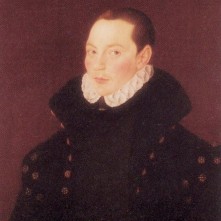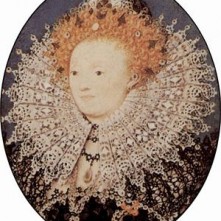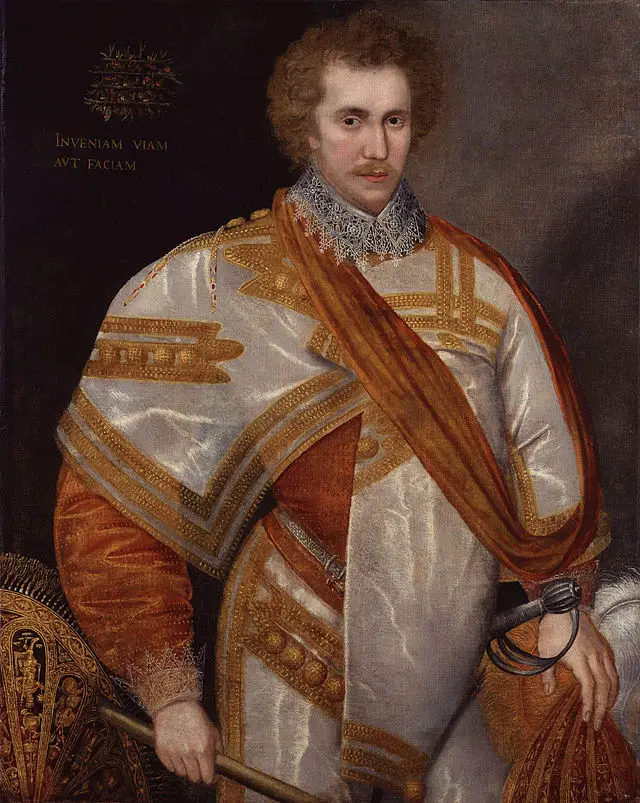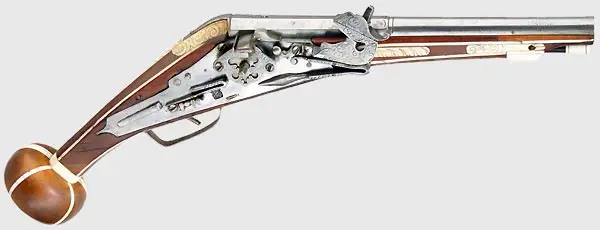16 November

Sir Francis Willoughby
1585 – Death of Gerald Fitzgerald, 11th Earl of Kildare and an Irish peer, in London. His body was taken to Kildare and buried there in February 1586. Fitzgerald was created Earl of Kildare and Baron of Offaly after helping put down Wyatt's Rebellion in 1554. He was imprisoned in the Tower of London twice for treason (1575 and 1582), but was cleared both times.
1596 – Death of Sir Francis Willoughby, industrialist and coalowner, in London. He was buried at St Giles Cripplegate. Willoughby is known for building Wollaton Hall in Nottinghamshire, developing coal mines on the estate, growing and processing woad there and in Ireland, and establishing two blast furnaces, for iron, at Middleton and Oakamoor, in Staffordshire, and buying one at Codnor in Derbyshire.
1601 – Death of Charles Neville, 6th Earl of Westmorland, nobleman and rebel, at Nieuwpoort in Flanders, while in exile. With the Percy family, the Nevilles had led the Rising of the North, a plot to release Mary, Queen of Scots and overthrow Elizabeth I. When the plot failed, Neville fled to Scotland and then on to Flanders. He was also involved in the Ridolfi Plot against Elizabeth.
1612 – Death of William Stafford, conspirator. Stafford was the son of William Stafford, widower of Mary Boleyn, and his second wife, Dorothy. Stafford was imprisoned in the Tower of London after being implicated in the plot of Baron de Châteauneuf, the French ambassador, to kill Elizabeth I. It is speculated that the plot was actually orchestrated by Walsingham and Cecil to show Elizabeth I that her life was in danger, and to persuade her to act against Mary, Queen of Scots. No charges were brought against Stafford, and he was released in 1588.
17 November

Elizabeth I
1525 – Death of Sir John Fyneux, Judge and Chief Justice of the King's Bench. He was appointed Chief Justice in 1495, and was also an executor of Henry VII's will.
1551 – Death of Richard Fermor, wool merchant, at Easton Neston. He was buried at the parish church there. Fermor was one of the jurors at the trial of Sir Richard Empson, and purchased the manor of Easton Neston from Empson's family. He was imprisoned at Marshalsea prison in May 1540 for misprision of treason, for supporting his Catholic chaplain who was vocal in his support of the Pope as head of the Church, but was released in August 1540 and pardoned in 1541.
1558 - Death of Mary I and accession of her half-sister Elizabeth I.
1558 – Death of Cardinal Reginald Pole, Mary I's Archbishop of Canterbury, at Lambeth Palace in London. He had been ill since September 1558 and died after hearing news of Mary I's death. He lay in state at the palace for forty days before being buried at Becket's Corona in Canterbury Cathedral.
1571 – Death of Sir Thomas Leigh, Lord Mayor of London. He was buried in the Mercer's Chapel. As Lord Mayor at the time of Elizabeth I's accession and coronation, he led Elizabeth's coronation procession.
1584 – Death of William Ayloffe, Justice of the Queen's Bench.
1589 – Death of Valentine Dale, member of Parliament, civil lawyer and diplomat, in the parish of St Gregory by Paul's in London. He was buried in the parish church there. Dale was sent on embassies to Flanders in 1563 and to Alexander Farnese, Duke of Parma, in 1588. He was on the commission which indicted Anthony Babington, and was also present at the trial of Mary, Queen of Scots. After Mary's trial, he wrote a memorandum justifying Mary's execution, at the behest of William Cecil, Lord Burghley.
18 November

Cuthbert Tunstall
1559 – Death of Ralph Baynes, Bishop of Coventry and Lichfield, during his imprisonment at the London home of Edmund Grindal, Bishop of London. He was buried in the church of St Dunstan-in-the-West, London. Baynes had been deprived of his bishopric and put into the care of Grindal in June 1559, due to his opposition to Elizabeth I's religious legislation.
1559 - Eighty-five year-old Cuthbert Tunstall, Bishop of Durham, died in prison at Lambeth Palace. He had had an amazing career, which spanned the reigns of Henry VIII, Edward VI and Mary I, but fell from grace in Elizabeth I’s reign after he refused to take the Oath of Supremacy and refused to participate in the consecration of Matthew Parker as Archbishop of Canterbury.
1600 – Death of William Hughes, Bishop of St Asaph and former chaplain to Thomas Howard, 4th Duke of Norfolk, at Diserth. He was buried in the cathedral choir. Hughes acted as patron to the Welsh poets William Cynwal, William Llŷn, and Siôn Tudur.
19 November

Robert Sidney
1564 – Death of Lord John Grey, youngest son of Thomas Grey, 2nd Marquis of Dorset and courtier. Grey was arrested with his brothers, Thomas and Henry (Duke of Suffolk and father of Lady Jane Grey), in 1554 for their involvement in Wyatt's Rebellion. Thomas and Henry were executed, and although John was condemned to death, he was released and pardoned due to the intercession of his wife, Mary, sister of Anthony Browne, Viscount Montagu.
1566 – Death of Reynold Corbet, member of Parliament and judge. He was buried at Stoke upon Tern in Shropshire. Corbet's offices included recorder of Shrewsbury, Justice of the Peace for Shropshire, a member of the Council in the Marches and Puisne Justice of the Queen's Bench.
1584 – Death of William Bendlowes, member of Parliament, Serjeant-at-Law and Law Reporter. He was buried at Great Bardfield in Essex, where his monumental brass can still be seen today. Bendlowes reported on court cases from the period 1534-1579.
1587 – Death of Henry Vaux, poet, Catholic recusant and priest harbourer, of consumption at Great Ashby, the home of his sister, Eleanor Brooksby. Vaux was sent to Marshalsea prison after being arrested in November 1586 for offering accommodation and assistance to Catholic priests. He was released in May 1587 due to ill health.
1590 – Death of Thomas Godwin, physician and Bishop of Bath and Wells, at Wokingham in Berkshire, his birthplace. He had retired there due to ill health, and was buried in the local church. Elizabeth I chose Godwin as one of her Lent preachers, and he served in that post for eighteen years.
1604 – Death of Richard Edes, Dean of Worcester, royal chaplain and court preacher, at Worcester. He was buried in Worcester Cathedral. Edes was a royal chaplain to Elizabeth I and James I, and had just been appointed to work on a new version of the English Bible when he died.
20 November

Christopher Hatton
1518 – Death of Sir Marmaduke Constable, soldier and administrator. He served in France with Edward IV and Henry VII, and although he fought on the side of Richard III at the Battle of Bosworth, he managed to gain Henry's trust. He commanded the left wing of the forces under Thomas Howard, Earl of Surrey, at the 1513 Battle of Flodden, and this service led to him receiving a letter of thanks from King Henry VIII.
1556 – Death of Sir John Godsalve, member of Parliament, landowner and administrator, at Norwich. He was buried in St Stephen's Church, Norwich, in the Lady Chapel. Godsalve's offices included Constable of Norwich Castle, Keeper of the Gaol there, commissioner for chantries in Norfolk and Suffolk, Justice of the Peace for Norfolk and Comptroller of the Tower of London Mint.
1558 – Death of Maurice Griffin, Bishop of Rochester, probably at the Bishop's Palace in Southwark. He was buried at the church of St Magnus the Martyr, London Bridge. Griffin was Welsh and he left provision in his will for the setting up of Friars School in Bangor, with the support of William Glyn, Bishop of Bangor, and Jeffrey Glyn.
1591 - Sir Christopher Hatton, Elizabeth I’s Lord Chancellor and favourite, died aged fifty-one. He died at Ely Palace in London. He had been ill for some time and Elizabeth I had visited him on the 11th November. He was given a state funeral on 16th December at the old St Paul’s Cathedral, and a monument was erected at the high altar. The old St Paul’s Cathedral was destroyed in the Great Fire of London in 1666.
1600 – Burial of Robert Wilson, actor and playwright, at St Giles Cripplegate in London. Wilson acted in the companies Leicester's Men and the Queen's Men, and is known for his plays which include “The Three Ladies of London” (1581), “The Three Lords and Three Ladies of London” (1590), “The Cobbler's Prophecy” (1594) and “The Pedlar's Prophecy” (1595). He was also one of Philip Henslowe’s writers, writing plays for the Rose Theatre.
1612 – Death of Sir John Harington, courtier, author and inventor of the flush toilet. He was buried at the family estate of Kelston, near Bath.
21 November

Tomb effigy of Frances Brandon.
1558 – Death of James Bassett, courtier and stepson of Arthur Plantagenet, Viscount Lisle. Bassett was a member of Philip of Spain's Privy Chamber and private Secretary to Mary I. He was buried at Blackfriars, London.
1559 - Frances Brandon, Duchess of Suffolk, died at Richmond. She was buried in St Edmund’s Chapel, Westminster Abbey, on the orders of her cousin, Queen Elizabeth I, and her second husband, Adrian Stokes, erected a tomb in her memory. Frances was the eldest daughter of Charles Brandon, Duke of Suffolk, and his third wife Mary Tudor, Queen of France, sister of Henry VIII, and she was the mother of Lady Jane Grey.
1579 – Death of Sir Thomas Gresham, merchant and founder of the Royal Exchange and Gresham College, at Gresham House in Bishopsgate, London. He was buried at St Helen's Church, Bishopsgate.
1613 – Death of Rose Throckmorton (née Lok), businesswoman and Protestant exile, at the age of eighty-six. Rose was the daughter of Sir William Lok, mercer and Gentleman Usher of the Chamber to Henry VIII, and in her memoirs she claimed that her father had been responsible for supplying Queen Anne Boleyn with religious books from the Continent.
22 November

Martin Frobisher
1545 - Henry VIII's trusted physician, Sir William Butts, died at Fulham Manor, Middlesex, after suffering from a “dooble febre quartanz”, a form of malaria. Butts was buried in a tomb against the south wall of All Saints Church, Fulham, but his tomb and brass were later destroyed. In 1627, his epitaph (a slab with verses by Sir John Cheke) was restored by Leonard Butts of Norfolk.
1559 – Proving of the will of Sir Andrew Dudley, second son of Edmund Dudley and brother of John Dudley, Duke of Northumberland. Dudley served Edward VI as a Gentleman of the Privy Chamber, Joint Keeper of the Palace of Westminster, keeper of the king's jewels and robes, and captain of Guînes. In 1553, he was sentenced to death for helping to put Lady Jane Grey on the throne, but was released in April 1555. His date of death is not known.
1594 – Death of Sir Martin Frobisher, naval commander, privateer and explorer, at Plymouth from gangrene. He had been shot in the thigh during hand-to-hand combat during the Siege of Fort Crozon. His entrails were buried at St Andrews, Plymouth, and his body was taken to London and buried at St Giles Cripplegate. Frobisher is known for the three voyages he made to the New World in search of the Northwest Passage, and his service during the Spanish Armada, for which he was knighted. After the Armada, he became one of Elizabeth I's most trusted officers and commanders.



Leave a Reply